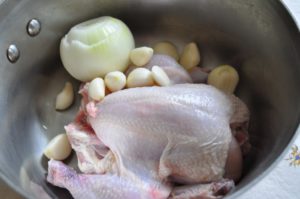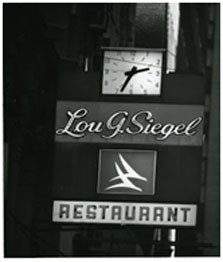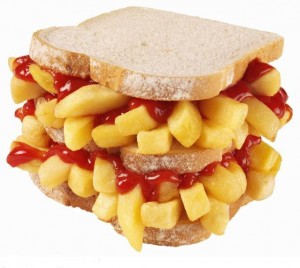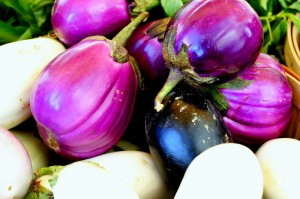HG’s two favorite writers on food and restaurants are Calvin Trillin and SJ (No nepotism. SJ’s blog, OishiGevalt.com, is both appetizing and brilliantly perceptive about many aspects of Japanese culture). HG shares with both writers a love for garlic and chicken fat, staples of HG’s late Mom’s Eastern European kitchen. Sammy’s Rumanian, the raucous, venerable restaurant in Manhattan’s lower east side features HG’s “Holy Trinity”: Garlic, Chicken Fat and Vodka. Here’s what Trillin has to say about Sammy’s: “Following the Rumanian tradition, garlic is used in excess to keep the vampires away. Following the Jewish tradition, a dispenser of schmaltz (liquid chicken fat) is kept on the table to give the vampires heartburn if they get through the garlic defense.”). Happy HG is looking forward to a dinner of chicken sautéed in olive oil with thirty gloves of garlic (plus lots of herbs from BSK’s garden). There will be a loaf of fresh ciabatta to soak up the juices and to spread with savory soft garlic. Count Dracula, beware!!!
Garlic And Chicken Fat
April 19th, 2018 § 0 comments § permalink
Schmaltz
August 23rd, 2016 § 0 comments § permalink
The Yiddish word “schmaltz” has entered the American lexicon. It is usually applied to entertainment, meaning corny or over sentimental. Schmaltz, of course, is chicken fat, the basis of much tasty Eastern European Jewish cuisine. When HG was a boy, HG’s Father took the little fellow to clothing shops on the Lower East Side. The shops were owned by friends of HG’s Father and there was much happy Yiddish conversation while little HG was praised for his good looks and intellect. A heavy mackinaw was bought in one place, ear flapped cap in another. Corduroy knickers climaxed the shopping. HG and Father lunched in one of the many “Romanian broilings” restaurants in the neighborhood (Sammy’s Romanian is the last remaining). Dad and son ate “carnezelach” (cigar shaped broiled chopped beef stuffed with chopped onions and garlic accompanied by fried “silver dollar” potatoes. There was a pitcher of chicken fat on the table and was poured generously over the dishes (plus the accompanying sliced raw onions and pumpernickel bread). HG still dreams about those lunches. Chicken fat is versatile. Obligatory with chopped liver. Great with mashed potatoes (or kasha) and fried onions. HG’s Mom added it to “tzimmes”, a long simmered dish of carrots, honey and cinnamon (plus chicken feet which added a gelatinous texture). Some Chinese chefs fry triangles of red pepper in chicken fat and use the peppers to top noodle dishes. Very hard to find chicken fat these days, but quite easy to render at home. Although, in a pinch, you can still find it online from some kosher food suppliers.
Music For Dining
July 15th, 2015 § 2 comments § permalink
During HG’s younger years in New York, there were many Hungarian (and Czech) restaurants on Lexington, Third and Second Avenues in the East 80’s and 90’s. The Czech restaurants specialized in tasty duck dishes. HG characterized the Hungarian eateries as “goulash by candlelight joints.” One of their common features was violin music provided by a “Gypsy” musician. The “Gypsy” would swoop down on individual tables and with many swooping gestures and soulful glances provide the diner with renditions of schmaltzy middle European cafe favorites. The object was to enhance the romantic mood of the diners. Somehow it worked (or maybe it was the copious amount of Egri Bikaver “Bull’s Blood” Hungarian red wine HG consumed). The “Gypsy” would continue to saw away until he was tipped. HG far preferred the “oompah, oompah” music provided by the band at Luchow’s, the glorious German restaurant on 14th Street. There were few jollier places in New York than Luchow’s during Christmas season when the venerable walls were adorned with holly and sparkling lights and the band focused on happy carols. Another pleasant winter music dining venue was the Edwardian Room of the Plaza Hotel. A cocktail pianist tinkled away in the background as diners ate in the handsome room gazing out at snow falling on Central Park. HG recalls a little steak house (name, alas, forgotten) where the owner, accompanied by a portable keyboard, sang show tunes to individual tables. His whiskey roughened voice was perfect for “Fugue for Tinhorns” from “Guys and Dolls.” And, then there’s Sammy’s Romanian on the Lower East Side. For many decades Sammy’s has featured music from singers, violinists and pianists singing old Yiddish music hall chestnuts and some popular melodies interspersed with low end, politically incorrect humor. The latest incarnation is Dani Luv, an Israeli born pianist with a killer Louis Armstrong impression. His audience, liberally stoked with vodka, garlic and chicken fat, is raucously appreciative.
“Where The Finest Jews Eat”
March 1st, 2015 § 2 comments § permalink
For many years that was the motto of Moskowitz & Lupowitz, a Romanian-Jewish restaurant on Second Avenue and Second Street in New York. It was a favorite of Groucho Marx, Milton Berle, Eddie Cantor, Sid Caesar and other theatrical luminaries. It was founded in 1909 by Romanian immigrants and for many years was owned and managed by Louis Anzelowitz until finally closing in 1966. It was one of HG’s favorite New York restaurants, offering a robust array of artery clogging traditional Eastern European Jewish dishes. (The loud Sammy’s Romanian on Chrystie Street is the last of the Romanian Jewish restaurants on the Lower East Side. Its menu is a pale shadow of the wonders once offered by M & L). When HG was a child M & L loomed large in HG’s imagination as he often heard their catchy jingle being sung by the Pincus Sisters on the Yiddish language radio station WEVD (named after socialist Eugene Victor Debs). M & L was the classiest Lower East Side restaurant with waiters in tuxedos and thickly carpeted floors. Despite the elegant atmosphere, it was never very expensive. In 1940 you could have a five course steak dinner for $1.35 (fruit juice, appetizer, soup, main dish, dessert). In 1962 you could have this meal for about $4.50. HG’s cardiologist would not have approved of HG’s typical M & L meal: Brains, sweetbreads, chicken livers or chopped liver with chicken fat and onions as an appetizer. This was followed by chicken soup with “kreplach” (meat filled dumplings). Main course was an M & L specialty: “Mushk” steak (rib steak) with “kasha varnishkes” (buckwheat groats with Farfalle pasta, fried onions and chicken fat.) Dessert was an afterthought: Stewed prunes (for digestive purposes). HG drank vodka with the appetizers, beer with the main course and Slivovitz (plum brandy) as a digestif. Plus Russian tea (strong black tea with a spoonful of cherry jam). HG often went to M & L with a stylish girl friend who ordered four appetizers as a meal (they had to be brought in succession by the waiter who grumbled as he made trips to the kitchen). The lady washed them down with Wild Turkey bourbon on the rocks. Pre-World War Two Lower East Side had many “Romanian broilings” restaurants. When little HG accompanied his father to that neighborhood to buy HG a winter outfit (heavy plaid mackinaw, corduroy knickers, cap with attached earmuffs) the two often would visit these joints to lunch on broiled “karnezelach” (beef, garlic and onion cigar-shaped hamburgers) with crisp “silver dollar” potatoes. At night, these places would transform and often featured a violinist playing Yiddish and Gypsy melodies. Italian mobsters and their Jewish gangland associates loved these rough and ready eateries. They were known as “Jew joints.” The bad guys never patronized Moskowitz & Lupowitx. Too classy. Too bourgeois. A “carpet” joint.
Schmaltz Is Back!
January 23rd, 2015 § 1 comment § permalink
Yes, schmaltz, delectable chicken fat, is making a comeback. It’s in the news. The New York Times recently reported that restaurant chefs and knowing home cooks are using the magical ingredient to enhance a variety of dishes. While some cardiologists and health police deride the golden goodness of chicken fat others are proving that, yes indeed, Moms may have been right all along citing schmaltz’s high level of heart healthy mono-saturated fats. Well, chicken fat may not be as good for the body as kale, but it provides real solace for the soul. HG’s favorite after school snack was a slice of Stuhmer’s pumpernickel bread covered with a good quarter-inch of chicken fat, kosher salt and black pepper. (Sometimes, HG’s thoughtful Mom added a slice of raw onion). Thus fortified, little HG was ready for competitive street games of punchball and “association” football. (The street was a playground in the 30’s and wartime 40’s since automobiles were scarce). HG’s Dad’s favorite use of chicken fat was in the form of “grieven” (or “gribenehs”). These were crisp, salty, lush bits of rendered chicken skin. The late, beloved Hershele Zvi Freimann would accompany this treat with a slice of rye bread and a modest tumbler of Park & Tilford rye whiskey. HG has a fond memory of HG’s Mom’s chopped hard boiled eggs and onions mixed with plenty of schmaltz. Her “latkes” (potato pancakes) fried in chicken fat were superior. There was plenty of chicken fat in her chopped liver. This was accompanied by slices of pungent black radish, also liberally gilded with schmaltz. The Temple of Schmaltz is Sammy’s Romanian Restaurant on New York’s Lower East Side. There’s a pitcher of schmaltz on every table. There’s also a bottle of vodka encased in ice. So, be assured, a raucous, inebriated, nostalgic good time is to be had. A schmaltzy joint, indeed.
New York Nostalgia Part 3 (The Jews)
January 24th, 2014 § 0 comments § permalink
Two events, one tragic and one sad, took place in New York City some 18 years ago. For HG, these events marked the end of New York’s Jewish ambience. Sure, the New York of that time, like today, had multitudes of Italians, Irish, African-Americans, Asians, and Hispanics. But, it was the Jews who set the overall tone of the city. The tragic event took place on March 5, 1996. On that day, Abe Lebewohl, the proprietor of the original Second Avenue Delicatessen (2nd Avenue and 10th Street), was shot and killed as he delivered cash receipts to a nearby bank. Lebewohl not only ran a great Jewish delicatessen, he was also a direct link to Second Avenue’s colorful past as the home of Yiddish theater. And, he honored that past by naming one of the delicatessen’s dining rooms after Molly Picon, a Yiddish musical star (and a favorite of HG’s Mom). Wonderful Jewish delicatessens like Gitlitz (79th and Broadway) are gone. Katz’s remains on the Lower East Side — a stalwart in these lean deli times where the venerable Carnegie Deli has devolved into a grotesque tourist trap known only for the over-stuffed size of their sandwiches.
The sad event was the closing of Lou G. Siegel’s on June 29, 1996. It had been in business for 79 years. Lou G. Siegel was a distinguished and dignified restaurant in the heart of New York’s Garment Center (38th Street just west of Seventh Avenue). It was strictly kosher (there were two Rabbis on the payroll) and the food was delicious, hearty and caloric. It was where observant Jewish (were there any other?) clothing executives dined. The non-observant big shot Jews ate at Al Cooper’s, further east on 38th. The garment workers frequented Dubrow’s and the other very good cafeterias in the vicinity. They are all gone. Seventh Avenue has been named “Fashion Avenue”. The Garment Center with its rabid union members, gangsters and famed lunchtime schmooze is now the Fashion District. The habitues of Siegel’s kingdom of chicken fat and rugelach would have a sardonic laugh. Siegel’s was the best of a host of traditional kosher restaurants that served meat ( Kosher law, “kashriuth”, forbids the mingling of meat and dairy products). Some of the other restaurants of that type were Moskowitz & Lupowitz and Gluckstern’s. Sammy’s Romanian (Allen and Delancey) is a survivor. The food (non-kosher) is tasty. The prices are steep. The atmosphere is a Jewish parody, a broad dialect joke. The great, strictly dairy (and fish) Jewish restaurants (Ratner’s, Rappaport’s, Steinberg’s, Paradise) are gone although some smaller operations still exist. This is not to say that there aren’t kosher restaurants left in New York — There are plenty of them spread throughout the five boroughs, catering to a new generation of the observant and a new group of Israeli and Russian Jewish immigrants. The menus would be un-recognizable to the observant Jews of fifty years ago as they feature kosher sushi, kosher Italian and kosher Indian food (amongst others). The restaurants HG misses most are those that were not kosher and had wide ranging menus that included, but were not confined to, Eastern European Jewish food. The three greatest, of course, were Lindy’s, Reuben’s and Tip Toe Inn. Gone. New York has, for better or worse, lost much of its Jewish flavor. It is now a truly international city with a cuisine to match. No, New York is no longer Jewish but it if you are hungry it’s a great town.
The Goldsteins (R.I.P.): Porn & Pastrami
December 19th, 2013 § 0 comments § permalink
Al Goldstein, the eccentric publisher of Screw magazine and pioneer of hard core, “non socially redeeming” porn is dead. At one point in his very checkered career (according to the Times obit) he was a “greeter” at the 2nd Avenue Delicatessen in New York. Only met Al once (when he was a deranged teenager) but his father, Sammy, was a pal. Sammy, a news photographer at International News Photos, loved to eat. (so did Al, who once weighed 350 pounds). When HG was a photo editor at INP, HG and Sammy (a pastrami addict), shared many meals at the 2nd Avenue Deli and Katz’s. (The duo also overate at Ratner’s, Sammy’s, Dubiner’s,Rappaport’s and other Lower East Side eateries). Sammy was a very good boxing photographer. HG has a vivid memory of Sammy at Madison Square Garden (then on 8th Avenue) ringside putting down his Speed Graphic between rounds to munch on (you guessed it) a pastrami on rye.
Rule Brittania Pt. 2: The Chip Butty
July 7th, 2013 § 1 comment § permalink
Browsing through a delightful food and drink writing anthology, Second Helpings–A Taste of The Glenfiddich Awards, HG came upon an extreme example of English eccentricity: A glowing testimony to a greasy, unhealthy high caloric pub treat called Chip Buttty. HG mused that “Chip Butty” would be an appropriate name for a gay porno actor. The culinary Chip Butty is a sandwich. It is composed of heavily buttered white bread. Indeed, the bread should “ooze” butter. The sandwich filling is French fries, preferably fried in lard or beef suet. A dash of malt vinegar, a squirt of ketchup and sprinkles of salt and pepper complete this treat. HG presumes this should be consumed in a pub with tankards of warm brown ale. Football (soccer) on the telly. Drunken football chants being chanted. Possibly, HG is being harsh. After all, HG is a lover of some pretty reprehensible and messy treats like the chow mein sandwiches served on hamburger buns you can still procure from Nathan’s Famous hot dog stand at New York’s Coney Island. And, at Sammy’s Romanian Restaurant on New York’s Lower East Side, HG likes to smother fried “half dollar” potatoes and other dishes with abundant amounts of golden chicken fat. Unhealthy, greasy — but not truly eccentric — is an HG sandwich favorite: Salami and eggs on an onion roll (pletzel). The salami (heavily fatty and garlicky Jewish salami available from Zabar’s and Katz’s Deli in New York) should be cooked with scrambled eggs pancake style. Onions fried until crisp in chicken fat are a nice addition.
Versatile Eggplant
October 15th, 2012 § 0 comments § permalink
It’s eggplant season. There are tiny, round eggplants on display at the Santa Fe Farmers’ Market. Also, slim Japanese eggplants. BSK has been cutting up the little round ones into cubes and sauteeing them with chopped tomatoes, basil, olive oil and garlic. BSK adds chopped, fresh mozzarella for Pasta a la Norma, a favorite in Sicily. HG and BSK first tasted it on a sunny Sicilian terrace overlooking the beautiful ruins of a Greek temple. Unfortunately, Sicily is wholly associated in the American mind with the nefarious activities of mafiosi. Sure, that’s part of Sicily. What doesn’t get enough attention are the Greek ruins, the extraordinary architecture and street food of Palermo and Taormina, a city with some of the most spectacular sea views in the world. Okay, enough about Sicily, let’s get back to those eggplants: BSK also sautes slices of the round, seasonal eggplants for a nice accompaniment to grilled lamps chops. HG likes to roast the Japanese eggplants. Cuts them open and eats with a bit of Chinese hoisin sauce.Those big eggplants one finds in supermarkets throughout the year are full of water. Best use for them is HG’s Baba Ganoush. HG roasts these eggplants until they are soft. Scoops out the insides and mashes them with olive oil, loads of garlic, some finely chopped onion, Spanish smoked paprika, chopped parsley. Dusts them with Zaatar, that lovely middle eastern spice mixture. HG gets much much applause when the Baba Ganoush is served with a chunk of feta cheese, Kalamata olives and warm pita.
Pickled egglplant is a classic, Italian antipasti dish, the best example of which SJ discovered at G. Esposito & Son’s Jersey Pork Butchers. You can find a middle European version of chopped eggplant at Sammy’s Roumanian Steak House on New York’s lower east side. Very heavy on the garlic and best accompanied by shots of vodka from a bottle frozen in ice. HG’s all time favorite eggplant dish can be found at good Chinese restaurants that feature cooking from the Szechuan and Hunan areas. Sometimes combined with chopped pork, these eggplant dishes stoke the mouth flames with an abundance of hot chile and Szechuan peppercorns. Pass the cold beer…
If You Can’t Eat It, Hum It!
February 29th, 2012 § 2 comments § permalink
“Shrimpers and rice are very nice. Hold tight. Hold tight. Hold tight. Hold tight. Foo-doo-racka-sacka. I want some seafood Mama.” Yes, the inimitable Fats Waller sang the great Sidney Bechet masterpiece, “Hold Tight (Want Some Seafaood Mama) with brio. There are plenty of great food related songs because, well food and music go together like chicken and rice.
HG’s late, beloved father had a favorite performer on the Yiddish vaudeville and musical stage: Aaron Lebedoff (sometimes spelled “Lebedeff”). He was famous for his rendition of “Roumania, Roumania.” In this bravura piece, Aaron extolls the virtues of mamaliga (a Roumanian version of polenta), karnezelach (cigar shaped hamburgers containing abundant chopped onion and garlic) and Roumanian wine. The singer describes Roumania as “ah lahnd a zeeseh, ah shayneh” (a sweet and beautiful land). Forgotten is the fact that this “sweet” land was the site of the terrible Kishinev pogroms in which scores of Jews were murdered.
HG has always been bemused by the fact that once Jews arrived in the United States (The Goldeneh Medina) they looked back on the blood soaked Old Country with misty eyed nostalgia. “Odessa Mama,” “Beltz, Mein Shtetele Beltz,” are just two of scores of immigrant songs celebrating various Old County cities and villages. Even HG’s normally clear eyed father could go on at length about the splendor of Odessa ice cream and the physical beauty of the Belarus countryside.
When HG accompanied his father to the Lower East Side to purchase little HG’s winter wardrobe of corduroy knickers and a heavy tweed mackinaw they often lunched at restaurants that advertised “Roumanian Broilings” in Yiddish and English signs. HG was (and is) very fond of the karnezelach and chicken fat fried potatoes he devoured there. Inevitably, the restaurant sound track had Lebedoff singing his signature song. There were many Roumanian restaurants on the Lower East Side. Only the schmaltz soaked Sammy’s survives. You can hear Lebedoff singing “Roumania, Roumania” on YouTube. Helluva performer. Helluva song.








